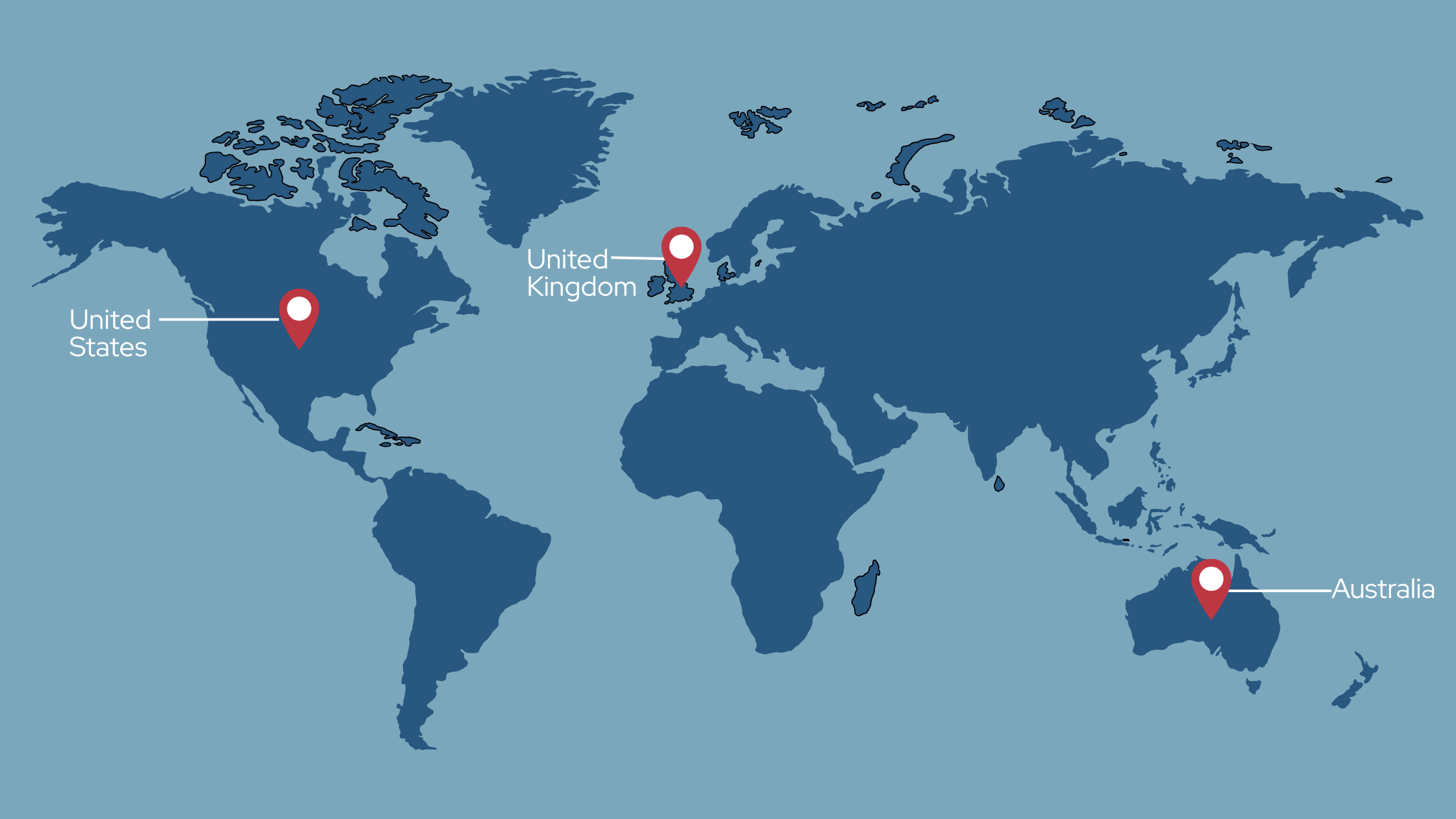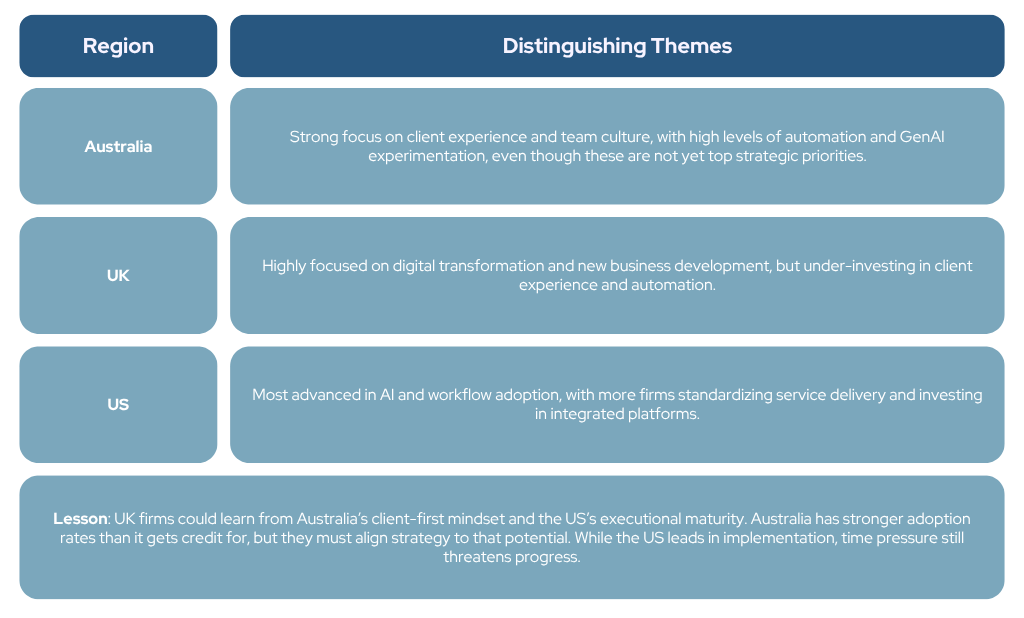The Law Firm Showdown: Exploring the Similarities and Differences of Midsize Law Firms Worldwide

Across the globe, midsize law firms are navigating a common era of transformation, but how they choose to adapt, evolve, and operate varies. From shifting client expectations to economic uncertainty and the rapid rise of advanced legal technology, the pressures facing midsize firms are universal. Yet, the strategies firms deploy to address them often reflect local priorities, cultural norms, and market conditions.
To explore both the shared challenges and regional distinctions, we analyzed industry insights from Actionstep’s 2025 Midsize Law Firm Priorities Reports across Australia, the United Kingdom, and the United States. Drawing on the perspectives of hundreds of legal and operational professionals, these reports reveal a rich global picture of how midsize firms have been rethinking their approach to growth, efficiency, technology, talent, and more.
Shared challenges, local responses
1. People and client experience are central but not equally prioritized
Every firm recognizes that talent and client relationships are mission critical. However, how much they prioritize each, and how effectively they deliver, varies.
- Australia: 59% of law firm professionals see talent retention as a core challenge, and 71% identify client satisfaction as the most important strategy for revenue protection.
- UK: 78% of firms say attracting and retaining staff is their top business priority and only 33% cite client satisfaction as a top concern—despite 59% admitting to inconsistent service delivery.
- US: 43% of law firm professionals say client satisfaction is their number one business priority in driving revenue. In fact, having documented client service expectations have grown by 33% since 2023.
Takeaway: Australia firms lead the pack when it comes to aligning internal culture with external client focus. The UK shows a potential blind spot—firms value their people but may be underestimating the power of client retention. In the US, law firm professionals are making progress in improving identified client service gaps.
2. Time: The universal bottleneck
Every region is battling time constraints. But what suffers as a result differs.
- Australia: 74% of law firm professionals say time and workload pressures are the top barrier to delivering exceptional client experience.
- UK: 70% of firms report that time constraints are preventing service improvements.
- US: 34% of professionals say they’re too busy to act on already-developed client satisfaction plans.
Takeaway: Intention is not the issue, but execution is a factor. Firms from each location are struggling to carve out time from their legal work for strategic client initiatives, even when the benefits are clearly understood.
3. Tech: One goal, many paths
Firms understand that technology is no longer a nice-to-have, but how firms use it, and how far along they are, looks very different across markets.
- Australia: 64% of law firm professionals are investing in tech to boost efficiency but actual adoption is stronger than it first appears with 38% already using process automation and 28% experimenting. GenAI usage sits at 9%, with 28% exploring it. However, automation still isn’t seen as a top strategic priority (only 6% say it’s their main focus), and many firms cite competing priorities and a lack of dedicated internal resources as blockers to faster tech adoption.
- UK: 74% of firms are actively seeking new tech, and 73% want more automation. Yet only 19% prioritize automation and just 26% report experimenting with GenAI tools. Cost and resistance to change remain key hurdles to further tech adoption.
- US: 59% of law firm professionals say their firm is “very motivated” to invest in tech adoption is more advanced with 33% using workflow automation, 36% using AI for legal research, 33% for document drafting, and 27% for client intake. Still, many firms face integration challenges and internal misalignment between teams, which slows down the impact of tech investments.
Takeaway: UK firms show strong interest in technology, but many are still in the early stages of adoption—with barriers like cost and resistance to change slowing progress. Australian firms are actively piloting automation and GenAI tools, even if these aren’t yet top strategic priorities. Firms in the US are further along, embedding tech into daily operations and seeing measurable impact. Across all regions, there’s room to better connect technology investments to client outcomes and firm efficiency. The path to adoption may differ, but one thing is clear: the return on investment in automation and AI is too valuable to ignore.
A legal tech leaderboard: What can each market learn from the others?

Global takeaways for midsize firms
Here are four global lessons for midsize firms looking to lead in 2025 and beyond:
1. Connect people strategy to real capacity
Your team is your biggest asset. But they can’t deliver great work if they’re overwhelmed. Firms across all regions are struggling with time constraints. Strategic goals like improving client satisfaction or innovation often fall flat because there’s simply no capacity to execute them. Creating capacity isn’t just about hiring more staff. It’s about giving your existing people systems, workflows, and flexibility they need to reduce admin, streamline tasks, and remove friction. Invest in a connected tech ecosystem, starting with a modern practice management platform that eliminates double entry and integrates seamlessly with your other tools. Reevaluate your workflows—are they delivering what they were designed to? Look for opportunities to automate routine steps, trigger timely reminders, and build in the kind of flexibility that allows staff to thrive, not just survive.
2. Don’t chase new business at the expense of retention
Winning new clients might seem like the obvious path to growth, but the real opportunity lies in retaining and expanding the relationships you already have.
Australian firms are leading in this area, with 71% focusing on client satisfaction to drive and protect revenue. This points to a strategic shift: putting long-term relationships ahead of short-term acquisition.
Retention isn’t just about goodwill. It requires consistent communication, streamlined intake, and service experiences that build trust over time. Systems that support this like automated status updates, client portals, and consistent workflows, help firms turn satisfied clients into long-term advocates. Other regions may be wise to follow Australia’s lead in putting loyalty and experience at the center of their growth plans.
3. Use technology to differentiate, not just streamline
Across all markets, firms understand the value of technology, but not all are using it to full effect.
In the US, firms are applying tools like workflow automation, AI, and client intake platforms to directly improve service delivery. Meanwhile, Australian firms are actively experimenting, and UK firms are still overcoming adoption barriers.
The key takeaway? Efficiency is just the starting point. Tools that reduce friction internally, like automated document templates or client intake forms, also create consistency and transparency for clients. That’s where real differentiation happens.
Leading firms are using tech to elevate service and scale smart.
4. Make time for execution
Time consistently came up as a top barrier for execution on strategy across all three reports.
From stalled client experience initiatives in the US to overloaded teams in the UK and Australia, firms have the ambition to improve—but not the capacity to act.
This is where small changes to process and priorities can unlock progress. That means reducing admin wherever possible, removing duplication, and designing workflows that make bottlenecks visible. Execution takes time and space. Protecting both will be a key differentiator for firms looking to turn strategy into action in 2025 and beyond.
Midsize firms across the globe are in a uniquely powerful position. They face the same pressures as their larger and smaller peers, but often with more agility, sharper focus, and fewer legacy barriers.
Those who take a clear-eyed look at what their peers are doing globally and apply the best ideas to their own context will be the firms to watch in future years to come.
Explore the full reports
Australian Midsize Law Firm Priorities Report 2025


